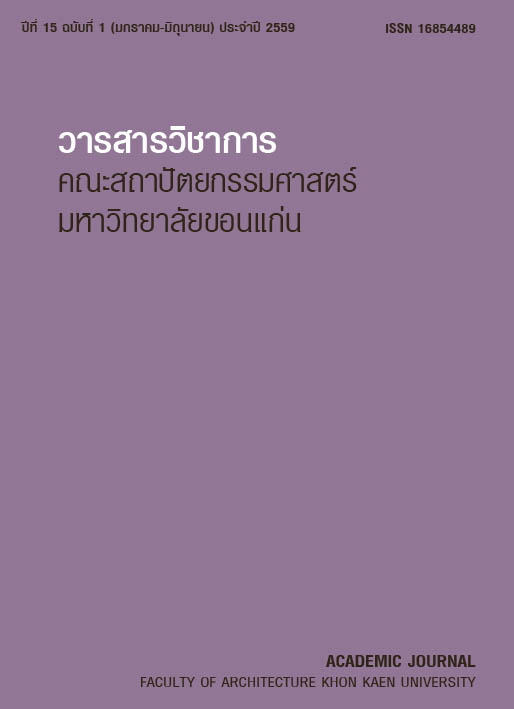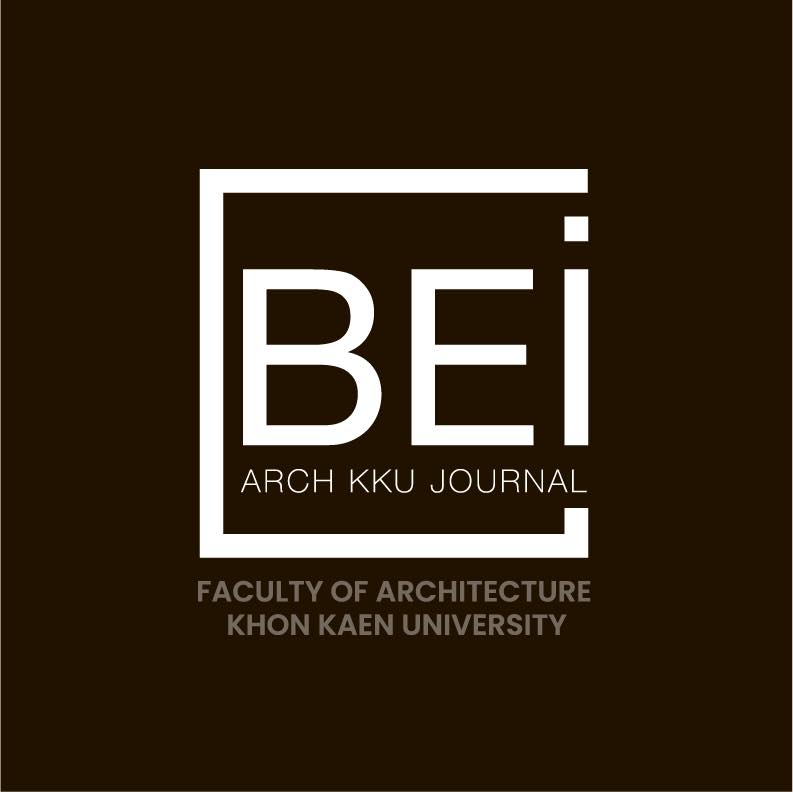การใช้เซลล์แสงอาทิตย์บนหลังคาอาคารคณะสถาปัตยกรรมศาสตร์ มหาวิทยาลัยขอนแก่น เพื่อการประหยัดพลังงาน Using Photovoltaic System on The Faculty of Architecture’s Building Rooftop in Khon Kaen University for Energy Conservation
คำสำคัญ:
เซลล์แสงอาทิตย์, มูลค่าปัจจุบันสุทธิ, อัตราส่วนผลประโยชน์ต่อต้นทุน, อัตราผลตอบแทนภายในของโครงการ, ต้นทุนต่อหน่วยไฟฟ้า, Photovoltaic, PV, Net Present Value, NPV, Benefit Cost Ratio, B/C Ratio, Internal Rate of Return, IRR, Cost of Electricity,บทคัดย่อ
บทคัดย่องานวิจัยนี้มีจุดมุ่งหมายในการศึกษาการใช้เซลล์แสงอาทิตย์บนหลังคาอาคารคณะสถาปัตยกรรมศาสตร์ มหาวิทยาลัยขอนแก่น เพื่อการประหยัดพลังงาน จากการศึกษาลักษณะทางกายภาพของหลังคาอาคารคณะสถาปัตยกรรมศาสตร์ มหาวิทยาลัยขอนแก่น เพื่อติดตั้งเซลล์แสงอาทิตย์รุ่น SP200E บนหลังคาทางด้านทิศใต้ พบว่าสามารถติดตั้งเซลล์แสงอาทิตย์ได้เท่ากับ 793.50 ตารางเมตร ผลิตพลังงานไฟฟ้ารวมได้เท่ากับ 158,938.05 กิโลวัตต์-ชั่วโมงต่อปี หรือมีปริมาณพลังงานไฟฟ้าที่เซลล์แสงอาทิตย์สามารถผลิตได้ในช่วงเวลา 5 ชั่วโมงต่อวัน คือ ช่วงเวลา 9:30- 14:30 น. เท่ากับ 90.70 กิโลวัตต์-ชั่วโมง การศึกษาเปรียบเทียบระหว่างปริมาณพลังงานไฟฟ้าที่เซลล์แสงอาทิตย์สามารถผลิตได้ในช่วงเวลา 5 ชั่วโมงและปริมาณการใช้พลังงานไฟฟ้าจากอุปกรณ์ไฟฟ้าของคณะสถาปัตยกรรมศาสตร์ มหาวิทยาลัยขอนแก่น พบว่าสำหรับวันธรรมดา (วันจันทร์-ศุกร์) เซลล์แสงอาทิตย์สามารถผลิตพลังงานไฟฟ้าได้ 4.77% ของปริมาณการใช้พลังงานไฟฟ้าจากอุปกรณ์ไฟฟ้าในเวลา 24 ชั่วโมง และ 9.22% ของปริมาณการใช้พลังงานไฟฟ้าจากอุปกรณ์ไฟฟ้าในเวลา 5 ชั่วโมง สำหรับวันหยุด (วันเสาร์–อาทิตย์) เซลล์แสงอาทิตย์สามารถผลิตพลังงานไฟฟ้าได้ 33.24% ของปริมาณการใช้พลังงานไฟฟ้าจากอุปกรณ์ไฟฟ้าในเวลา 24 ชั่วโมง และ 112.11% ของปริมาณการใช้พลังงานไฟฟ้าจากอุปกรณ์ไฟฟ้าในเวลา 5 ชั่วโมง โดยได้เลือกใช้ระบบผลิตไฟฟ้าพลังงานแสงอาทิตย์แบบเชื่อมต่อสายส่ง (on-grid system) ชนิดหักลบหน่วย (net metering) ทำการติดตั้งเซลล์แสงอาทิตย์เฉพาะหลังคาด้านทิศใต้ที่ไม่ได้รับร่มเงาจากสภาพแวดล้อม โดยวางเซลล์แสงอาทิตย์ทำมุม 16 องศากับแนวพื้นดิน ใช้โครงสร้างและอุปกรณ์ในการติดตั้งเซลล์แสงอาทิตย์ที่ทำจากอลูมิเนียมและสแตนเลสชนิดที่สามารถติดตั้งบนวัสดุมุงหลังคาทุกชนิดผลการวิเคราะห์ความคุ้มค่าของโครงการจะได้ค่า NPV ติดลบ ค่า B/C Ratio มีค่าน้อยกว่า 1 และค่า IRR มีค่าน้อยกว่า 8% แสดงว่าผลตอบแทนที่ได้รับจากโครงการไม่มีความคุ้มค่าในการลงทุน มีระยะเวลาคืนทุนของโครงการเท่ากับ 11.76 ปี อย่างไรก็ตามหากมีการเปลี่ยนแปลงตามการวิเคราะห์ความอ่อนไหวของโครงการ เช่น เมื่อต้นทุนทั้งหมดเปลี่ยนแปลงน้อยกว่าหรือเท่ากับ 80% ของเงินลงทุนทั้งหมด หรือราคาของแผงเซลล์แสงอาทิตย์เปลี่ยนแปลงน้อยกว่าหรือเท่ากับ 15 บาทต่อวัตต์ หรืออัตราดอกเบี้ยเปลี่ยนแปลงน้อยกว่าหรือเท่ากับ 4% หรือสามารถจำหน่ายพลังงานไฟฟ้าได้เป็นเวลา 25 ปี และมีราคาจำหน่ายพลังงานไฟฟ้ามากกว่าหรือเท่ากับ 6 บาทต่อหน่วย เป็นต้น ค่า NPV จะเป็นบวก ค่า B/C Ratio จะมีค่ามากกว่า 1 และค่า IRR จะมีค่ามากกว่า 8% แสดงว่าผลตอบแทนที่ได้รับจากโครงการมีความคุ้มค่าในการลงทุน โดยเฉพาะอย่างยิ่งหากได้รับการสนับสนุนจากภาครัฐในการจำหน่ายพลังงานไฟฟ้าจากเซลล์แสงอาทิตย์บนหลังคาอาคารสถานศึกษา ประกอบกับการเป็นอาคารกรณีศึกษาที่ส่งเสริมภาพลักษณ์ให้กับคณะสถาปัตยกรรมศาสตร์ มหาวิทยาลัยขอนแก่น ในด้านอาคารประหยัดพลังงาน นับว่าเป็นผลตอบแทนที่คุ้มค่าในระยะยาวทั้งต่อคณะ มหาวิทยาลัย และประเทศไทยต่อไป AbstractThis research aims to study a way to use photovoltaic system (PV system) on a building rooftop of faculty of Architecture of Khon Kaen University for energy conservation. The study of physical characteristics of the roof on the southern side to install the PV system model SP200E found that the PV system can be installed in 793.50 square meters, and produce 158,938.05 kilowatt-hours of electricity per year. In addition, the amount of PV system can produce electricity 90.70 kilowatt-hours in 5 hours per day (9:30 AM to 14:30 PM). The study to compare the amount of electricity that PV system can produce in 5 hours period and the amount of electricity consumption from the electrical devices of the faculty of Architecture of Khon Kaen University found that within weekdays (Monday – Friday), PV system can produce electricity at 4.77% of electricity consumption from the electrical devices in 24 hours; and in 5 hours, PV system can produce electricity at 9.22% of electricity consumption from the electrical devices. For weekends (Saturday – Sunday), PV system can produce electricity at 33.24% of electricity consumption from the electrical devices in 24 hours; and PV system can produce electricity at 112.11% of electricity consumption from the electrical devices in 5 hours. To produce the aforementioned electricity, the PV system was connected with on-grid system and net metering, and located on the southern side of the roof where there always had no shade from environment; and put a 16 degree angle with the horizontal line. All the structures and equipment used are made of aluminum and stainless steel which can be installed on all types of roofing materials. The result of cost-benefit analysis of this PV system installing project showed that Net Present Value or NPV is negative: the B/C Ratio is less than one, and the IRR is less than 8. This signifies that the investment return of this project has no worthiness: the payback period is 11.76 years. However, the project will be worth investing in if changes are made based on the sensitivity analysis of the project: when the percentage of total cost changes to less than or equal to 80% out of the cost of investment, or the price of PV system changes to less than or equal to 15 baht per watt, or interest rate changes to less than or equal to 4%, or the distribution of PV system electricity can last for 25 years and the price of electricity is more than or equal to 6 baht per unit. So thus, the NPV will be positive, the B/C Ratio will be more than 1; and the IRR will be more than 8%. Furthermore, if the project is supported by the government, the building can be a case study and a good image of the faculty of Architecture of Khon Kaen University in terms of energy conservation building. This long-term return will definitely be worthwhile for the faculty, the university; and even the country.บทคัดย่อ
งานวิจัยนี้มีจุดมุ่งหมายในการศึกษาการใช้เซลล์แสงอาทิตย์บนหลังคาอาคารคณะสถาปัตยกรรมศาสตร์ มหาวิทยาลัยขอนแก่น เพื่อการประหยัดพลังงาน จากการศึกษาลักษณะทางกายภาพของหลังคาอาคารคณะสถาปัตยกรรมศาสตร์ มหาวิทยาลัยขอนแก่น เพื่อติดตั้งเซลล์แสงอาทิตย์รุ่น SP200E บนหลังคาทางด้านทิศใต้ พบว่าสามารถติดตั้งเซลล์แสงอาทิตย์ได้เท่ากับ 793.50 ตารางเมตร ผลิตพลังงานไฟฟ้ารวมได้เท่ากับ 158,938.05 กิโลวัตต์-ชั่วโมงต่อปี หรือมีปริมาณพลังงานไฟฟ้าที่เซลล์แสงอาทิตย์สามารถผลิตได้ในช่วงเวลา 5 ชั่วโมงต่อวัน คือ ช่วงเวลา 9:30- 14:30 น. เท่ากับ 90.70 กิโลวัตต์-ชั่วโมง การศึกษาเปรียบเทียบระหว่างปริมาณพลังงานไฟฟ้าที่เซลล์แสงอาทิตย์สามารถผลิตได้ในช่วงเวลา 5 ชั่วโมงและปริมาณการใช้พลังงานไฟฟ้าจากอุปกรณ์ไฟฟ้าของคณะสถาปัตยกรรมศาสตร์ มหาวิทยาลัยขอนแก่น พบว่าสำหรับวันธรรมดา (วันจันทร์-ศุกร์) เซลล์แสงอาทิตย์สามารถผลิตพลังงานไฟฟ้าได้ 4.77% ของปริมาณการใช้พลังงานไฟฟ้าจากอุปกรณ์ไฟฟ้าในเวลา 24 ชั่วโมง และ 9.22% ของปริมาณการใช้พลังงานไฟฟ้าจากอุปกรณ์ไฟฟ้าในเวลา 5 ชั่วโมง สำหรับวันหยุด (วันเสาร์–อาทิตย์) เซลล์แสงอาทิตย์สามารถผลิตพลังงานไฟฟ้าได้ 33.24% ของปริมาณการใช้พลังงานไฟฟ้าจากอุปกรณ์ไฟฟ้าในเวลา 24 ชั่วโมง และ 112.11% ของปริมาณการใช้พลังงานไฟฟ้าจากอุปกรณ์ไฟฟ้าในเวลา 5 ชั่วโมง โดยได้เลือกใช้ระบบผลิตไฟฟ้าพลังงานแสงอาทิตย์แบบเชื่อมต่อสายส่ง (on-grid system) ชนิดหักลบหน่วย (net metering) ทำการติดตั้งเซลล์แสงอาทิตย์เฉพาะหลังคาด้านทิศใต้ที่ไม่ได้รับร่มเงาจากสภาพแวดล้อม โดยวางเซลล์แสงอาทิตย์ทำมุม 16 องศากับแนวพื้นดิน ใช้โครงสร้างและอุปกรณ์ในการติดตั้งเซลล์แสงอาทิตย์ที่ทำจากอลูมิเนียมและสแตนเลสชนิดที่สามารถติดตั้งบนวัสดุมุงหลังคาทุกชนิด
ผลการวิเคราะห์ความคุ้มค่าของโครงการจะได้ค่า NPV ติดลบ ค่า B/C Ratio มีค่าน้อยกว่า 1 และค่า IRR มีค่าน้อยกว่า 8% แสดงว่าผลตอบแทนที่ได้รับจากโครงการไม่มีความคุ้มค่าในการลงทุน มีระยะเวลาคืนทุนของโครงการเท่ากับ 11.76 ปี อย่างไรก็ตามหากมีการเปลี่ยนแปลงตามการวิเคราะห์ความอ่อนไหวของโครงการ เช่น เมื่อต้นทุนทั้งหมดเปลี่ยนแปลงน้อยกว่าหรือเท่ากับ 80% ของเงินลงทุนทั้งหมด หรือราคาของแผงเซลล์แสงอาทิตย์เปลี่ยนแปลงน้อยกว่าหรือเท่ากับ 15 บาทต่อวัตต์ หรืออัตราดอกเบี้ยเปลี่ยนแปลงน้อยกว่าหรือเท่ากับ 4% หรือสามารถจำหน่ายพลังงานไฟฟ้าได้เป็นเวลา 25 ปี และมีราคาจำหน่ายพลังงานไฟฟ้ามากกว่าหรือเท่ากับ 6 บาทต่อหน่วย เป็นต้น ค่า NPV จะเป็นบวก ค่า B/C Ratio จะมีค่ามากกว่า 1 และค่า IRR จะมีค่ามากกว่า 8% แสดงว่าผลตอบแทนที่ได้รับจากโครงการมีความคุ้มค่าในการลงทุน โดยเฉพาะอย่างยิ่งหากได้รับการสนับสนุนจากภาครัฐในการจำหน่ายพลังงานไฟฟ้าจากเซลล์แสงอาทิตย์บนหลังคาอาคารสถานศึกษา ประกอบกับการเป็นอาคารกรณีศึกษาที่ส่งเสริมภาพลักษณ์ให้กับคณะสถาปัตยกรรมศาสตร์ มหาวิทยาลัยขอนแก่น ในด้านอาคารประหยัดพลังงาน นับว่าเป็นผลตอบแทนที่คุ้มค่าในระยะยาวทั้งต่อคณะ มหาวิทยาลัย และประเทศไทยต่อไป
Abstract
This research aims to study a way to use photovoltaic system (PV system) on a building rooftop of faculty of Architecture of Khon Kaen University for energy conservation. The study of physical characteristics of the roof on the southern sideto install the PV system model SP200E found that the PV system can be installedin 793.50square meters, and produce 158,938.05 kilowatt-hours of electricity per year. In addition, the amount of PV system can produce electricity 90.70 kilowatt-hours in 5 hours per day (9:30 AM to 14:30 PM). The study to compare the amount of electricity that PV system can produce in 5 hours period and the amount of electricity consumption from the electrical devices of the faculty of Architecture of Khon Kaen University found that within weekdays (Monday – Friday), PV system can produce electricity at 4.77% of electricity consumption from the electrical devices in 24 hours; and in 5 hours, PV system can produce electricity at 9.22% of electricity consumption from the electrical devices. For weekends (Saturday – Sunday), PV system can produce electricity at 33.24% of electricity consumption from the electrical devices in 24 hours; and PV system can produce electricity at 112.11% of electricity consumption from the electrical devices in 5 hours. To produce the aforementioned electricity, the PV system was connected with on-grid system and net metering, and located on the southern side of the roof where there always had no shade from environment; and put a 16 degree angle with the horizontal line. All the structures and equipment used are made of aluminum and stainless steel which can be installed on all types of roofing materials.
The result of cost-benefit analysis of this PV system installing project showed that Net Present Value or NPV is negative: the B/CRatio is less than one, and the IRR is less than 8. This signifies that the investment return of this project has no worthiness: the payback period is 11.76 years. However, the projectwill be worth investing in if changes are made based on the sensitivity analysis of the project: when the percentage of total costchanges to less than or equal to 80% out of the cost of investment, or the price of PV system changes to less than or equal to 15 baht per watt, or interest rate changes to less than or equal to 4%, or the distribution of PV system electricity can last for 25 years and the price of electricity is more than or equal to 6 baht per unit. So thus, the NPV will be positive, the B/C Ratio will be more than 1; and the IRR will be more than 8%. Furthermore, if the project is supported by the government, the building can be a case study and a good image of the faculty of Architecture of Khon Kaen University in terms of energy conservation building. This long-term return will definitely be worthwhile for the faculty, the university; and even the country.
ดาวน์โหลด
เผยแพร่แล้ว
รูปแบบการอ้างอิง
ฉบับ
ประเภทบทความ
สัญญาอนุญาต
ทัศนะและข้อคิดเห็นของบทความที่ปรากฏในวารสารฉบับนี้เป็นของผู้เขียนแต่ละท่าน ไม่ถือว่าเป็นทัศนะและความรับผิดชอบของกองบรรณาธิการ




